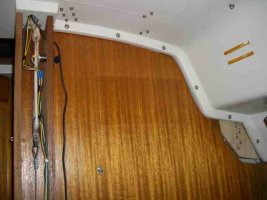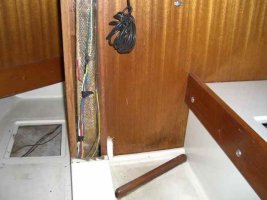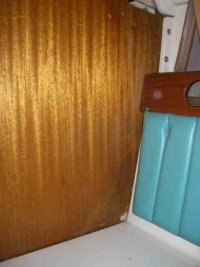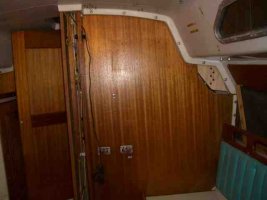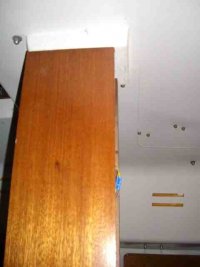I recently purchased a 1973 E25 that I am working to bring back up to respectable condition. One of the issues is replacement of the aft bulkheads where the chain plates attach. The port was easy to remove and use for a pattern. However, it appears the only way to replace the other is to cut it out and replace with at least two or three pieces. The top and outboard side with the molded liner etc prohibits the replacement of a one piece from the side and the cb trunk is also in the way. Any suggestions would be appreciated, method of replacement, type of marine plywood etc.
You are using an out of date browser. It may not display this or other websites correctly.
You should upgrade or use an alternative browser.
You should upgrade or use an alternative browser.
E25 Starboard Bulkhead Replacement
- Thread starter Wysailer
- Start date
Pictures of E25 Bulkheads
The pictures show the bulkhead and attachment tabs that are used to bolt the bulkhead in place at the top and sides. The mast support block, cb trunk and width of the bulkhead prevent the bulkhead from being removed intact. ope these pictures help describe the issus. I want to replace the bulkhead as the rot on the bottom edge and the previous owner(s) repair at the chain plate attachment look a bit suspect. Where the chain plate attaches the previous owner(s) installed two, front and back, stainless steel cover plates that I removed for these photos.
The pictures show the bulkhead and attachment tabs that are used to bolt the bulkhead in place at the top and sides. The mast support block, cb trunk and width of the bulkhead prevent the bulkhead from being removed intact. ope these pictures help describe the issus. I want to replace the bulkhead as the rot on the bottom edge and the previous owner(s) repair at the chain plate attachment look a bit suspect. Where the chain plate attaches the previous owner(s) installed two, front and back, stainless steel cover plates that I removed for these photos.
Attachments
Interesting...
I must be missing something... not seeing what ties the new piece of ply to the existing bulkhead. (For glassing two pieces together and achieving full strength one needs a 12 to 1 scarph joint.)
It must be just the camera angle but the patch piece looks to be just sitting there with no attachment.
Loren
I must be missing something... not seeing what ties the new piece of ply to the existing bulkhead. (For glassing two pieces together and achieving full strength one needs a 12 to 1 scarph joint.)
It must be just the camera angle but the patch piece looks to be just sitting there with no attachment.
Loren
Last edited:
I removed the stainless steel patch plates that covered the plywood patch and part of the original bulkhead so the patch would be visible.
Ahhh So.
As long as the finished repair achieved the strength of the whole bulkhead - that's what counts.
Did you open up the deck coring, dry it, dig it out, etc...., and replace the coring around the tang penetration with thickened epoxy?
LB
davisr
Member III
Loren,
You mention here a 12-to-1 scarph joint for the joining of the two pieces. In another recent thread titled "bulkhead repair," you mention this as well. I'm curious to know . . . if you were to do this repair yourself, with, say, two new pieces of plywood, would you orient the joint vertically or horizontally? The owner in the "bulkhead repair" thread decided to orient the joint vertically (using a lap joint). I seem to recall from all of the other bulkhead threads I've read in the past that the normal procedure is to orient the joint in a vertical direction. I don't know if this just so happens to be the easiest way to reinstall the plywood, or if is serves to provide some assistance to the compressive forces of the mast. Is seems, though, that with a vertical joint the two halves of the new bulkhead would, in some ways, be a war with one another. The half that's closest to the compression post would be subjected to a downward force. The half through which the chainplate is bolted, would, on the other hand, be pulled upward, in the opposite direction. Would, therefore, it be better to join to the two pieces horizontally? Just a thought. What do you think? Your the Forum wise man, so I really do think your opinion is worth more that two cents!!
Regards,
Roscoe
You mention here a 12-to-1 scarph joint for the joining of the two pieces. In another recent thread titled "bulkhead repair," you mention this as well. I'm curious to know . . . if you were to do this repair yourself, with, say, two new pieces of plywood, would you orient the joint vertically or horizontally? The owner in the "bulkhead repair" thread decided to orient the joint vertically (using a lap joint). I seem to recall from all of the other bulkhead threads I've read in the past that the normal procedure is to orient the joint in a vertical direction. I don't know if this just so happens to be the easiest way to reinstall the plywood, or if is serves to provide some assistance to the compressive forces of the mast. Is seems, though, that with a vertical joint the two halves of the new bulkhead would, in some ways, be a war with one another. The half that's closest to the compression post would be subjected to a downward force. The half through which the chainplate is bolted, would, on the other hand, be pulled upward, in the opposite direction. Would, therefore, it be better to join to the two pieces horizontally? Just a thought. What do you think? Your the Forum wise man, so I really do think your opinion is worth more that two cents!!
Regards,
Roscoe
Advice
I just read my posts and it may seem I have sounded a bit harsh.
The comments and posts are surely appreciated and I will look forward to hearing from any and all on anything they may have to offer.
Roscoe's post seems to carry some thought and I have thought about using a three part replacement of the bulkhead. The top and bottom would be separated by a middle piece that would have a spline on top and bottom and glued together. Then possibly glassing the thing together and placing a veneer over the top.
Scott
I just read my posts and it may seem I have sounded a bit harsh.
The comments and posts are surely appreciated and I will look forward to hearing from any and all on anything they may have to offer.
Roscoe's post seems to carry some thought and I have thought about using a three part replacement of the bulkhead. The top and bottom would be separated by a middle piece that would have a spline on top and bottom and glued together. Then possibly glassing the thing together and placing a veneer over the top.
Scott
wolly bugger
Member II
If you are considering replacing the entire bulkhead you could use 2 layers of 3/8" marine plywood. One layers having top and bottom parts and another layers 2 side by side parts all epoxy in place. Just a tough. Good luck with your project.
davisr
Member III
Stephan,
That's an ingenious solution, one that would resist both vertical and horizontal forces and would limit the stress on both joints. I guess that comes with all your professional carpentry experience.
You know . . . there's a wooden boat-building yard down the street from me. They use the cold molding technique, which involves the use of epoxy, cloth, and alternating pieces of marine grade plywood in the construction of hulls. They say it's incredibly strong, as do others.
What kind of joint would you use, if you replaced your bulkhead with your described method?
Roscoe
That's an ingenious solution, one that would resist both vertical and horizontal forces and would limit the stress on both joints. I guess that comes with all your professional carpentry experience.
You know . . . there's a wooden boat-building yard down the street from me. They use the cold molding technique, which involves the use of epoxy, cloth, and alternating pieces of marine grade plywood in the construction of hulls. They say it's incredibly strong, as do others.
What kind of joint would you use, if you replaced your bulkhead with your described method?
Roscoe
wolly bugger
Member II
I think a butt joint will be just fine since the epoxy will spread the load over the entire pieces. If someone wanted to get fancier, one could make a lap joint for added strength where the pieces meet.Stephan,
What kind of joint would you use, if you replaced your bulkhead with your described method?
Roscoe
Joint
Davisr,
I see what you mean about forces acting on a vertical joint but on the 30+ the bulkhead is heavily bolted in two places. I would think (hope) that this arrangement would lessen any movement in the joint area. Also on the Bristol as well as the Ericson, the bulkhead was not attached to the compression post, glued, screwed or otherwise. I don't know if should glue the new bulkhead into the slot or leave it as it was originally.
Davisr,
I see what you mean about forces acting on a vertical joint but on the 30+ the bulkhead is heavily bolted in two places. I would think (hope) that this arrangement would lessen any movement in the joint area. Also on the Bristol as well as the Ericson, the bulkhead was not attached to the compression post, glued, screwed or otherwise. I don't know if should glue the new bulkhead into the slot or leave it as it was originally.
exoduse35
Sustaining Member
leave the edges unglued as per the original. There is a certain amount of movement that is needed and designed for. Te hull does flex and any attempt to secure that flex (in this case by gluing in the bulkhead) will either move the flex to a weaker area of the hull, or simply tear out. Edd
davisr
Member III
John,
Will you be glassing the outer edge of the bulkhead to the hull with tabs? In other words, you're saying that you would leave the inner edge, by the compression post floating? I ask, because I noticed in your pictures on your thread that your boat does not, or at least appears not to have a hull liner (which, in a lot of ways, is a good thing). The white tabs on the E25 are part of the hull liner. It's through these tabs that the bulkhead bolts run. In other words, it's impossible on an E25 to glass the bulkhead to hull.
Roscoe
Will you be glassing the outer edge of the bulkhead to the hull with tabs? In other words, you're saying that you would leave the inner edge, by the compression post floating? I ask, because I noticed in your pictures on your thread that your boat does not, or at least appears not to have a hull liner (which, in a lot of ways, is a good thing). The white tabs on the E25 are part of the hull liner. It's through these tabs that the bulkhead bolts run. In other words, it's impossible on an E25 to glass the bulkhead to hull.
Roscoe
Tabbing
Roscoe
The bulkhead on the 30+ was tabbed in only a few places. Just outboard of the chainplate to the side of the hull, one small spot just inboard of the chainplate to the underside of the cabin top and a little bit near the compression post. I intend to add more tabbing than original when I install the new bulkhead.
The E25 arrangement is very similar to the Bristol 22, that notch that the bulkhead fits into. On the Bristol there were no bolts in that notch. The bulkhead was tabbed all along the bottom and side. I work on a TV show in the city whose season just ended. In a few weeks I will have alot more time to work on the boat and I will be posting more pictures, I will post pictures of the Bristol project if that will help Scott.
John
Roscoe
The bulkhead on the 30+ was tabbed in only a few places. Just outboard of the chainplate to the side of the hull, one small spot just inboard of the chainplate to the underside of the cabin top and a little bit near the compression post. I intend to add more tabbing than original when I install the new bulkhead.
The E25 arrangement is very similar to the Bristol 22, that notch that the bulkhead fits into. On the Bristol there were no bolts in that notch. The bulkhead was tabbed all along the bottom and side. I work on a TV show in the city whose season just ended. In a few weeks I will have alot more time to work on the boat and I will be posting more pictures, I will post pictures of the Bristol project if that will help Scott.
John

